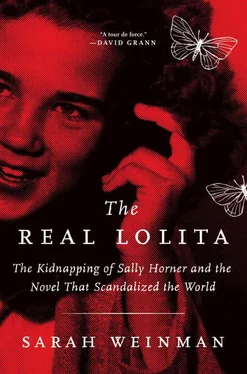The more months that slipped by without answers, the greater the existential toll on Sally Horner’s family. Ella bore the brunt of it. Sally was her daughter. She’d let the girl go off with a stranger because he’d said he was the father of school friends, who were waiting for her down by the Jersey Shore. She believed the lies the man forced her daughter to tell, and now the girl was gone.
Perhaps Ella entertained fleeting thoughts that Sally was dead, but she never admitted it in public. She’d found work as a seamstress for Quartermaster Depot, so at least there was enough money coming in to keep the lights on in the house, as well as the telephone in operation. Sally hadn’t called home again, but if she ever chose to, it would be a disaster if the line was disconnected.
Ella aired her anguish in a December 10, 1948, article published by the Philadelphia Inquirer, headlined “A Christmas Tree Glows, a Lonely Mother Waits.” Sally had been missing for nearly half a year by that point. Ella kept a figurative candle burning for the time when her daughter would return home safe. And with Christmas a little more than two weeks away, the tree Ella set up was, according to the unbylined reporter, “freighted with memories of other and happier Christmases,” a means of multiplying the “candle’s tiny gleam.” Ella could think of no better way to express her faith that Sally would come back to her.
When that happened—Ella could not allow herself to think “if,” only “when”—Sally would have to contend with one very big change to the family. Her niece, Diana, was five months old when the article appeared in the Inquirer . But Diana’s arrival couldn’t help but be bittersweet for her grandmother, Susan, and her husband, as long as they had no clue to Sally’s whereabouts. Sally had so looked forward to being an aunt.
The young couple buried their uncertainty and despair in the daily care of their new baby. Changing diapers, rocking her to sleep, trying to get much-needed rest in small bursts. They also had the family greenhouse to look after—the flowers and plants wouldn’t grow themselves.
Ella was thrilled to be a grandmother. But her joy was always tempered so long as Sally wasn’t here with her. And as she told the Inquirer, the moment Sally walked back through the front door at 944 Linden Street, she would not be punished in any way. “Whatever she has done, I can forgive her for it. If I can just have her back again.”
SALLY HORNER’S TWELFTH BIRTHDAY, on April 18, 1949, came and went with no news. Had she vanished into the ether? Would her body turn up? Or was Sally out there, ready to be found, hoping that she would come home again? Camden police kept the case open, and Marshall Thompson tracked every lead.
The case had taken on added urgency a month earlier, on March 17, when the Camden County prosecutor’s office added a second, more serious, indictment of kidnapping to the existing charge against La Salle. Where abduction carried a maximum prison sentence of only a few years, a kidnapping conviction upped the ante to between thirty and thirty-five years—effectively, for someone of Frank La Salle’s age, a life sentence.
No documents have survived to explain the more serious charge. Perhaps the prosecutor, or the Camden Police Department, had received a credible tip to La Salle’s whereabouts and hoped that news of the new indictment might flush him out. Or perhaps there were concerns about the statute of limitations on the original abduction charge if Sally stayed missing for a long time, or even forever.
The media moved on from covering the story. No one marked the first anniversary of her disappearance. At Christmas 1949, they did not publicize appeals for Sally’s safe return. Other sensational local crimes pushed her out of the papers, including a mass shooting on Camden’s East Side and another mysterious disappearance: that of the wife of Jules Forstein, a Philadelphia magistrate.
Dorothy Forstein’s disappearance baffled investigators. She had spent the previous four years in a state of anxiety after an unknown assailant nearly killed her just outside her front door. On the evening of October 18, 1949, Dorothy’s husband, Jules, attended a party on his own. He said he asked Dorothy to come with him, but she insisted she’d rather stay home with the children, stepdaughter Marcy, nine, and their seven-year-old, Edward.
When Jules got home at 11:30 P.M. Dorothy was gone and the children were frantic. They claimed a stranger had come into the house, knocked their mother unconscious, and then hefted the five-foot-two, 125-pound woman, clad in pajamas and red slippers, over his shoulder, carrying her out and locking the door behind them. Before he left, he patted Marcy on the head and told her, “Go back to sleep.” Marcy recalled that he was wearing a brown cap and “something brown in his shirt.”
Jules said he did not report Dorothy missing right away because he thought Marcy was telling a fib, and believed— oddly, considering her near-agoraphobia—that his wife must still be in the neighborhood. He called police four and a half hours later, just before 4:00 A.M. The police also brushed off Marcy’s story as fantasy. Then a female psychiatrist was called in to question the little girl, and after several lengthy conversations, the psychiatrist concluded Marcy was telling the truth about what happened that night.
Over the next few days, people reported sightings of the missing woman all over the Philadelphia area. Camden also figured in the initial investigation. The Friday night after Dorothy vanished, Camden patrolman Edward Shapiro noticed a blond woman hovering around the corner of Broadway and Fourth Street. Shapiro told Philadelphia detectives he first saw the woman coming out of a telephone booth next to a candy store. She seemed startled to see him, and he was himself startled by how much she resembled Dorothy Forstein. Shapiro followed her to a tavern, where she ordered a beer, but when the woman noticed him again, she split.
The following night, Shapiro saw the woman again on the same corner, and overheard her speaking with a male companion. “I’ve only got one arm,” he heard the woman say. This statement caused detectives to perk up. One of Dorothy’s lingering injuries from her earlier attack was a recurrent dislocated shoulder that landed her in the hospital for treatment several times a year. Detectives were certain Dorothy, even under a false name, might turn up at a hospital to have her shoulder reset again. She did not. A thousand-dollar reward offered by Jules Forstein yielded no new leads. Dorothy was declared legally dead eight years later, in 1957, a year after her husband had died of a heart attack at home.
SALLY’S FAMILY took the waning public interest as a sign that it was better not to speak of her disappearance, even among themselves. Her absence was a low thrum, ever-present but unacknowledged. Of course they worried. Of course they feared for her safety. But no news meant no answers, and her fate was beyond their control. It was better to carry on with life.
Baby Diana turned one in August 1949. She was, by her parents’ account and her own later recollection, a happy little girl, eager and talkative, who loved eating Grape-Nuts and drinking apple juice. Al ran the greenhouse, and Susan stopped in when she was up to it. Ella remained at 944 Linden Street, but living there was like a nightmare. “It was so different when Sally was here,” she later recalled. “She was so cheerful and full of life.”
Ella had difficulty sleeping. Many times in the night she would leave her room and go to Sally’s. She would take out her daughter’s toys and games and “just sit there and look at them.” Ella washed and rewashed Sally’s clothes “so they would be ready for her when she came back.”
Читать дальше












